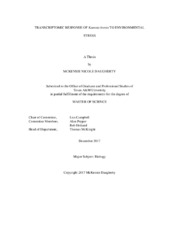| dc.description.abstract | Karenia brevis is a toxic, marine phytoplankton that forms harmful algal blooms in the Gulf of Mexico. This toxicity is due to the production of ladder-frame polyketides known as brevetoxins, for which the production pathway and function in the cell are not known. Osmotic stress has been shown to increase the production of brevetoxin in K. brevis, and recent studies implicate the toxin as linked to the function of light harvesting complex II in the thylakoid membrane. Understanding if whether brevetoxin production and photosynthetic stress are linked in an osmotic shock response will shed further light on its function in the cell. Using K. brevis clones with high, average, low, and non-detectable levels of brevetoxin, we explored the response to osmotic stress using analysis of differential gene expression, measurements of PAM fluorometry, and production of the known osmolyte glycerol. Brevetoxin-producing clones of K. brevis showed lower expression in Photosystem II genes, and correspondingly lower photosynthetic efficiencies and intracellular glycerol concentrations in response to stress. In contrast, clones that produce non-detectable and low toxin levels showed no significant stress response, and also showed a deficiency in Non-Photochemical Quenching (NPQ) compared to toxic cultures. This observation supports the potential link between reactive oxygen species and NPQ pathways that is related to the presence of brevetoxin in K. brevis. Further, brevetoxin producing K. brevis clones respond to osmotic stress by utilizing photosynthesis for osmoacclimation and through small molecule degradation, in particular intracellular photosynthetically derived glycerol, whereas the low and non-detectable clones do not. | en |


